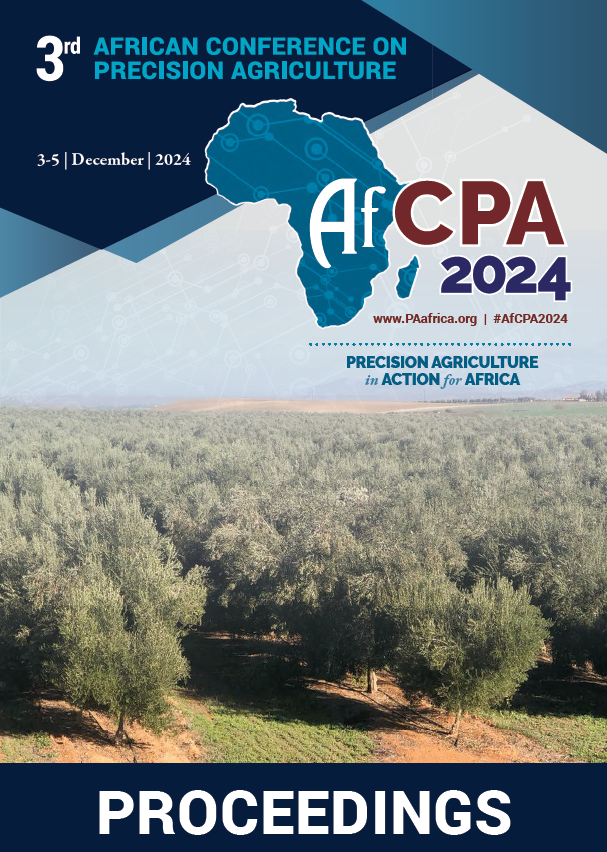Download the Conference Proceedings
Proceedings
Authors
| Filter results7 paper(s) found. |
|---|
1. Decision Support System for Precision Agriculture management Case study : El Salihiya –east Nile delta, Egypt.Soil is a complex mixture of living organisms and organic material, along with soil minerals. the main objective of this work is develop a new methods to improve the agricultural management .The current study relies on developing a decision-making model for agricultural operations to manage potato crops in the El Salihiya area using field data,laboratory analysis and field sensor measurements. The precision agriculture decision support system entitled (EGYPADS) was designed and developed... A. Belal , S. abd el-kader, B. Mamdouh , M. A el-shirbeny, M. abdellatif1, M. Jalhoum , M. Zahran, E.S. Mohamed |
2. Mapping of micronutrients status in soils under multivarietal Citrus sinensis production for precision agricultureCitrus production in Nigeria is below the world average; and this is caused among other things by poor soil management. The situation is further acerbated by blanket fertilizer application and low application of precision in soil fertility management. A study was carried out on a 34 year old multi varietal citrus orchard under sweet orange (Citrus sinensis) to determine the current soil fertility status and variability of micronutrients. Soil samples were collected at a sampling depth... B.N. Okafor, B.N. Okafor, V. Aduaramigba, O. Denton |
3. Chlorophyll Meter Based Precision Nitrogen Management in Maize Grown in Alluvial Soil in EgyptPrecision nitrogen (N) management is essential for profitable crop production and to minimize N losses to the environment that are a consequence of an excessive N supply. Chlorophyll meter-based N management can help to achieve high N use efficiency, as aquick and non-destructive spectral characteristics of leaves, which can be used to diagnose plant N deficiency and graduate N fertilization with improve N use efficiency. Field experiments were conducted during two consecutive years, 2019 and... A. Soaud, S. Abou-zeid , A. Ali, D. Hassan |
4. Analyse De La Variabilité Spatiale Des Rendements De Maïs (Zea Mays L.) Dans Les Régions Des Savanes Et Centrale Du TogoL'agriculture de précision s'impose au Togo. Une étude a été menée dans 5 préfectures du Togo, dont 2 dans la région des Savanes (Oti et Kpendjal) et 3 dans la région Centrale (Sotouboua, Tchamba et Tchaoudjo) avec un total de 20 producteurs en 2021. d'analyser la variation spatiale du rendement en grain du maïs (variété Ikenne) au sein de chaque région sous deux pratiques de gestion agricoles incluant :... M. Lare, J. Sogbedji, K. Lotsi, K. Amouzou, A. Ale gonh-goh, A. Agneroh |
5. Recommandation De Formules De Fertilisation Site-spécifique Pour La Production Du Maïs Dans La Région Des Savanes Du TogoDans le contexte actuel de la dégradation des terres agricoles et des difficultés de disponibilité et d'accès aux intrants agricoles en particulier les engrais, la maximisation de l'efficience d'utilisation des nutriments en nutrition des plantes devient plus que jamais une nécessité. Nous avons conduit en 2020 sous culture de maïs (Zea mays L.), des essais soustractifs à base de l'azote (N), du phosphore (P) et du potassium... M. Lare, J. Sogbedji, K. Lotsi, K. Amouzou, A. Ale gonh-goh, A. Agneroh |
6. Post-Harvest Assessments of On-Farm Maize ExperimentationThe completion of the most recent maize-growing seasons in northern Cote d’Ivoire and Kenya (western and eastern regions) provided a first opportunity for farmers to share assessments from their participation in a new on-farm research initiative for sub-Saharan Africa called NUTCAT - meaning Nutrient-Catalyzed Agricultural Transformation. ... I. Adolwa |
7. Capacity Building of African Young Scientists in Precision Agriculture Through Cross Regional Academic MobilityClimate change is one of the main problems affecting food and nutrition globally, particularly in sub-Saharan Africa. Adapting to and/or mitigating climate change in the agri-food sector requires merging information technologies, genetic innovations, and sustainable farming practices to empower the agricultural youth sector to create effective and locally adapted solutions. Precision Agriculture applied to crops (PAAC), has been advocated as a strategic solution to mitigate/adapt agriculture at... K. Frimpong, V. Fassinou hotegni, A. Karangwa, A. Manyatsi, M. Amri, D. Cammarano, C. Lesueur, J. Taylor, S. Phillips, E.G. Achigan-dako, G. Houessou, O. Linkpon, D. Tchokponhoué, C. Houdegbe, C. Adje |
